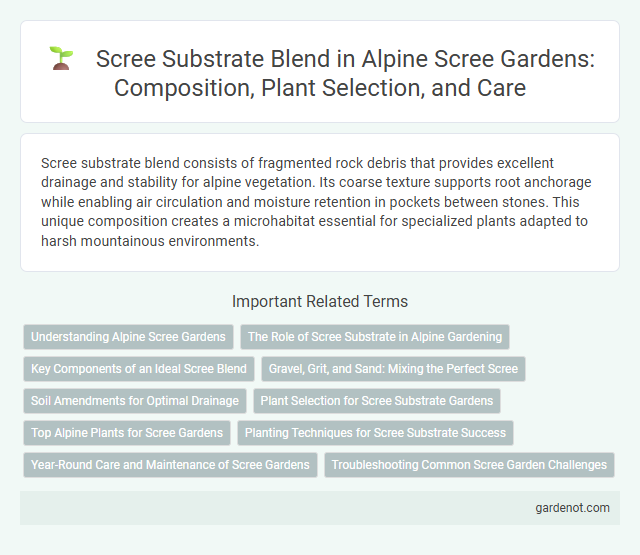Scree substrate blend consists of fragmented rock debris that provides excellent drainage and stability for alpine vegetation. Its coarse texture supports root anchorage while enabling air circulation and moisture retention in pockets between stones. This unique composition creates a microhabitat essential for specialized plants adapted to harsh mountainous environments.
Understanding Alpine Scree Gardens
Scree substrate blend in alpine scree gardens mimics the natural rocky debris found on mountain slopes, ensuring optimal drainage and stability for alpine plants. This blend typically combines coarse sand, gravel, and small stones to replicate the harsh, well-drained conditions essential for scree-adapted species. Understanding these substrate characteristics allows gardeners to cultivate resilient alpine flora by fostering an environment that supports root aeration and minimizes moisture retention.
The Role of Scree Substrate in Alpine Gardening
Scree substrate, composed of loose, coarse rock fragments, mimics the natural alpine environment crucial for plant root aeration and drainage. This substrate blend prevents waterlogging and supports the growth of specialized alpine flora by providing stability and essential mineral nutrients. Its role in alpine gardening is vital for replicating harsh, well-drained mountainous conditions that enable stress-tolerant plants to thrive.
Key Components of an Ideal Scree Blend
An ideal Alpine scree substrate blend combines coarse angular gravel, sand, and fine mineral particles to ensure optimal drainage and root aeration for native alpine plants. Key components include well-graded crushed rock fragments, typically 5-20 mm in size, which mimic natural scree texture and support stability while preventing waterlogging. Incorporating mineral-rich, low-organic content materials enhances nutrient availability without compromising the substrate's structural integrity, essential for scree ecosystem resilience.
Gravel, Grit, and Sand: Mixing the Perfect Scree
Gravel, grit, and sand form the essential components of a well-balanced scree substrate blend, providing optimal drainage and root stability for alpine plants. Gravel offers coarse texture and aeration, grit enhances drainage capacity, and sand fills finer gaps to create a firmly packed yet permeable surface. This precise mixture mimics natural scree slopes, supporting healthy growth and preventing waterlogging in alpine gardening environments.
Soil Amendments for Optimal Drainage
Scree substrate blend enhances alpine scree environments by incorporating coarse sand, gravel, and organic matter to improve soil aeration and water drainage. Soil amendments such as perlite, pumice, and crushed lava rock increase porosity, preventing water retention and root rot. These components create an optimal balance tailored for alpine plants, promoting healthy root development and nutrient uptake.
Plant Selection for Scree Substrate Gardens
Selecting plants for scree substrate gardens requires choosing species adapted to well-drained, rocky environments with minimal soil retention. Ideal plants include drought-tolerant alpines such as saxifrages, sedums, and dryas, which thrive in nutrient-poor, gravelly substrates and provide stabilization to loose scree. Incorporating native species enhances ecological compatibility and supports local biodiversity in alpine scree habitats.
Top Alpine Plants for Scree Gardens
Scree substrate blends for Alpine gardens consist of a well-draining mix of coarse sand, gravel, and organic matter to replicate natural mountain drainage conditions. Top Alpine plants for scree gardens include Saxifraga, Androsace, and Draba species, which thrive in rocky, nutrient-poor soils while offering vibrant blooms and compact growth. Proper substrate composition enhances root aeration and moisture control, essential for the survival and flourishing of these specialized plants in harsh alpine environments.
Planting Techniques for Scree Substrate Success
Scree substrate blend requires well-draining, gritty soil composed of crushed stone, sand, and organic matter to mimic natural alpine conditions. Planting techniques emphasize positioning seedlings with roots securely embedded in pockets of coarse substrate to ensure stability and optimal moisture retention. Regular monitoring of soil pH and moisture levels supports root establishment and prevents fungal growth in challenging scree environments.
Year-Round Care and Maintenance of Scree Gardens
Scree substrate blend ensures proper drainage and mimics the natural rocky environment essential for alpine scree gardens, promoting healthy root development. Year-round care involves monitoring soil moisture to prevent waterlogging while maintaining well-drained conditions, especially during thaw periods. Regular removal of debris and occasional replenishment of substrate materials sustain optimal aeration and nutrient balance for resilient scree plant growth.
Troubleshooting Common Scree Garden Challenges
Scree substrate blend requires precise drainage and the right angular rock mix to prevent waterlogging and root rot in alpine scree gardens. Adjusting particle size distribution and incorporating coarse gravel can alleviate compaction issues and promote healthy root aeration. Regular monitoring of soil pH and moisture levels helps troubleshoot nutrient deficiencies and supports resilient scree vegetation growth.
Scree substrate blend Infographic

 gardenot.com
gardenot.com